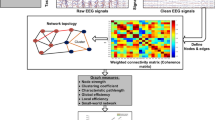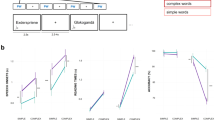Abstract
The reading process takes place in a neuronal network comprising the inferior frontal, posterior dorsal and posterior ventral brain areas. It is suggested that developmental dyslexia is caused by a disruption of the two posterior network areas. What remains debatable is whether these areas are affected in their functionality or whether the neuronal networking (connectivity) of these areas suffer from a disturbed information transfer. Thus, it is of major interest to investigate the time flow of the directed information transfer (time variant connectivity) within the neuronal reading network of dyslexic subjects. We investigated adolescents with dyslexia and normal-reading controls with functional magnetic resonance imaging and electroencephalography (EEG) with a paradigm addressing basic visual, orthographic and phonological processing. EEG data were analyzed with the time variant Granger causality index (tvGCI) to investigate the temporal order of the directed information transfer (time variant causal connectivity: which network node passes when information to which network node) during reading in dyslexic readers. Results show that the reading network of dyslexic readers comprises the same brain areas as identified in normal-reading subjects. The tvGCI analysis of the network profiles of dyslexic readers indicates that dyslexics show a difference in timing and localization of connectivity within this reading network compared to normal readers. Dyslexic readers use right hemisphere language areas to counterbalance posterior left hemisphere processing deficits. The compensatory involvement of homologue right hemisphere brain areas for the reading process may be the neurobiological background for the significantly longer reading times by dyslexics.







Similar content being viewed by others
References
American Electroencepahlographic Society (1994) Guideline thirteen: guidelines for standard electrode position nomenclature. J Clin Neurophysiol 11(1):111–113
Arnold M, Miltner WHR, Witte H, Bauer R, Braun C (1998) Adaptive AR modeling of nonstationary time series by means of Kalman filtering. IEEE Trans Biomed Eng 45:553–562
Booth JR, Mehdirattaa N, Burmana DD, Bitan T (2008) Developmental increases in effective connectivity to brain regions involved in phonological processing during tasks with orthographic demands. Brain Res 189:78–89
Epelbaum S, Pinel P, Gaillard R, Delmaire C, Perrin M, Dupont S et al (2008) Pure alexia as a disconnection syndrome: new diffusion imaging evidence for an old concept. Cortex 44(8):962–974
Fiez JA, Tranel D, Seager-Frerichs D, Damasio H (2006) Specific reading and phonological processing deficits are associated with damage to the left frontal operculum. Cortex 42(4):624–643
Granger CWJ (1969) Investigating causal relations by econometric models and cross-spectral methods. Econometrica 37(3):424–438
Gratton G, Coles MGH, Donchin E (1983) A new method for off-line removal of ocular artefact. Electroencephalogr Clin Neurophysiol 55:468–484
Grissemann H (2000) Zürcher Lesetest (ZLT). Hans Huber, Göttingen
Grünling C, Ligges M, Huonker R, Klingert M, Mentzel HJ, Rzanny R et al (2004) Dyslexia: the possible benefit of multimodal integration of fMRI- and EEG-data. J Neural Transm 111(7):951–969
Hampson M, Tokoglu F, Sun ZD, Schafer RJ, Skudlarski P, Gore JC et al (2006) Connectivity-behavior analysis reveals that functional connectivity between left BA39 and Broca’s area varies with reading ability. Neuroimage 31(2):513–519
Hemmelmann D, Ungureanu M, Hesse W, Wüstenberg T, Reichenbach JR, Witte OW et al (2009) Modelling and analysis of time-variant directed interrelations between brain regions based on BOLD-signals. Neuroimage 45(3):722–737
Hesse W, Möller E, Arnold M, Schack B (2003) The use of time-variant EEG Granger causality for inspecting directed interdependencies of neural assemblies. J Neurosci Methods 124(1):27–44
Jäger A (1974) Rechtschreibtest R–T. Hogrefe, Göttingen
Jobard G, Crivello F, Tzourio-Mazoyer N (2003) Evaluation of the dual route theory of reading: a metanalysis of 35 neuroimaging studies. Neuroimage 20(2):693–712
Katzir T, Misra M, Poldrack RA (2005) Imaging phonology without print: assessing the neural correlates of phonemic awareness using fMRI. Neuroimage 27(1):106–115
Klicpera C, Klicpera BG (1998) Psychologie der Lese- und Schreibschwierigkeiten. Psychologie Verlags Union, Weinheim
Kronbichler M, Hutzler F, Staffen W, Mair A, Ladurner G, Wimmer H (2006) Evidence for a dysfunction of left posterior reading areas in German dyslexic readers. Neuropsychologia 44(10):1822–1832
Kujala J, Pammer K, Cornelissen P, Roebroeck A, Formisano E, Salmelin R (2007) Phase coupling in a cerebro-cerebellar network at 8–13 Hz during reading. Cereb Cortex 17(6):1476–1485
Leistritz L, Hesse W, Wustenberg T, Fitzek C, Reichenbach JR, Witte H (2006) Time-variant analysis of fast-fMRI and dynamic contrast agent MRI sequences as examples of 4-dimensional image analysis. Methods Inf Med 45(6):643–650
Ligges M (2002) fMRI-Untersuchung von Sprachverarbeitungsprozessen bei der Lese-Rechtschreibstörung. Thesis, Friedrich-Schiller-Universität, Jena
Ligges C, Blanz B (2007) Survey of fMRI results regarding a phonological deficit in children and adults with dyslexia: fundamental deficit or indication of compensation? Z Kind Jugendpsych Psychother 35(2):107–117
Maisog JM, Einbinder ER, Flowers DL, Turkeltaub PE, Eden GF (2006) A metes-analysis of functional neuroimaging studies of dyslexia. Paper presented at the 25th Rodin remediation conference, 11–13 Oct 2006, Washington, DC
Paulesu E, Frith U, Snowling M, Gallagher A, Morton J, Frackowiak RSJ et al (1996) Is developmental dyslexia a disconnection syndrome? Evidence from PET scanning. Brain 119:143–157
Pugh KR, Mencl WE, Jenner AR, Katz L, Frost SJ, Lee JR et al (2000) Functional neuroimaging studies of reading and reading disability (developmental dyslexia). Ment Retard Dev Disabil Res Rev 6(3):207–213
Quaglino V, Bourdin B, Czternasty G, Vrignaud P, Fall S, Meyer ME et al (2008) Differences in effective connectivity between dyslexic children and normal readers during a pseudoword reading task: an fMRl study. Clin Neurophysiol 38(2):73–82
Ramus F (2003) Developmental dyslexia: specific phonological deficit or general sensorimotor dysfunction? Curr Opin Neurobiol 13(2):212–218
Rathenow P (1980) Westermann Rechtschreibtest 6+. Braunschweig
Raven J (1996) Matrizen-test-manual band 1. Beltz-Test GmbH, Göttingen
Richards TL, Berninger VW (2008) Abnormal fMRI connectivity in children with dyslexia during a phoneme task: before but not after treatment. J Neuroling 21(4):294–304
Saur D, Kreher BW, Schnell S, Kummerer D, Kellmeyer P, Vry MS et al (2008) Ventral and dorsal pathways for language. Proc Natl Acad Sci USA 105(46):18035–18040
Shaywitz BA, Skudlarski P, Holahan JM, Marchione KE, Constable RT, Fulbright RK et al (2007) Age-related changes in reading systems of dyslexic children. Ann Neurol 61(4):363–370
Vigneau M, Beaucousin V, Herve PY, Duffau H, Crivello F, Houde O et al (2006) Meta-analyzing left hemisphere language areas: phonology, semantics, and sentence processing. Neuroimage 30(4):1414–1432
Weiss T, Hesse W, Ungureanu M, Hecht H, Leistritz L, Witte H et al (2008) How do brain areas communicate during the processing of noxious stimuli? An analysis of laser-evoked event-related potentials using the Granger causality index. J Neurophysiol 99(5):2220–2231
Acknowledgments
This research was supported by grants from the Deutsche Forschungsgemeinschaft (DFG BL 435/3-2 and Wi 1166/10-1) and by a Marie-Curie-Intra-European Fellowship (M.U., 041 452, NADIBA).
Conflict of interest statement
The authors declare that they have no conflict of interest with the funding institution.
Author information
Authors and Affiliations
Corresponding author
Additional information
C. Ligges and M. Ungureanu contributed equally to the publication and therefore both are considered as first authors.
Carolin Ligges: Birth name Grünling.
Rights and permissions
About this article
Cite this article
Ligges, C., Ungureanu, M., Ligges, M. et al. Understanding the time variant connectivity of the language network in developmental dyslexia: new insights using Granger causality. J Neural Transm 117, 529–543 (2010). https://doi.org/10.1007/s00702-010-0367-x
Received:
Accepted:
Published:
Issue Date:
DOI: https://doi.org/10.1007/s00702-010-0367-x




